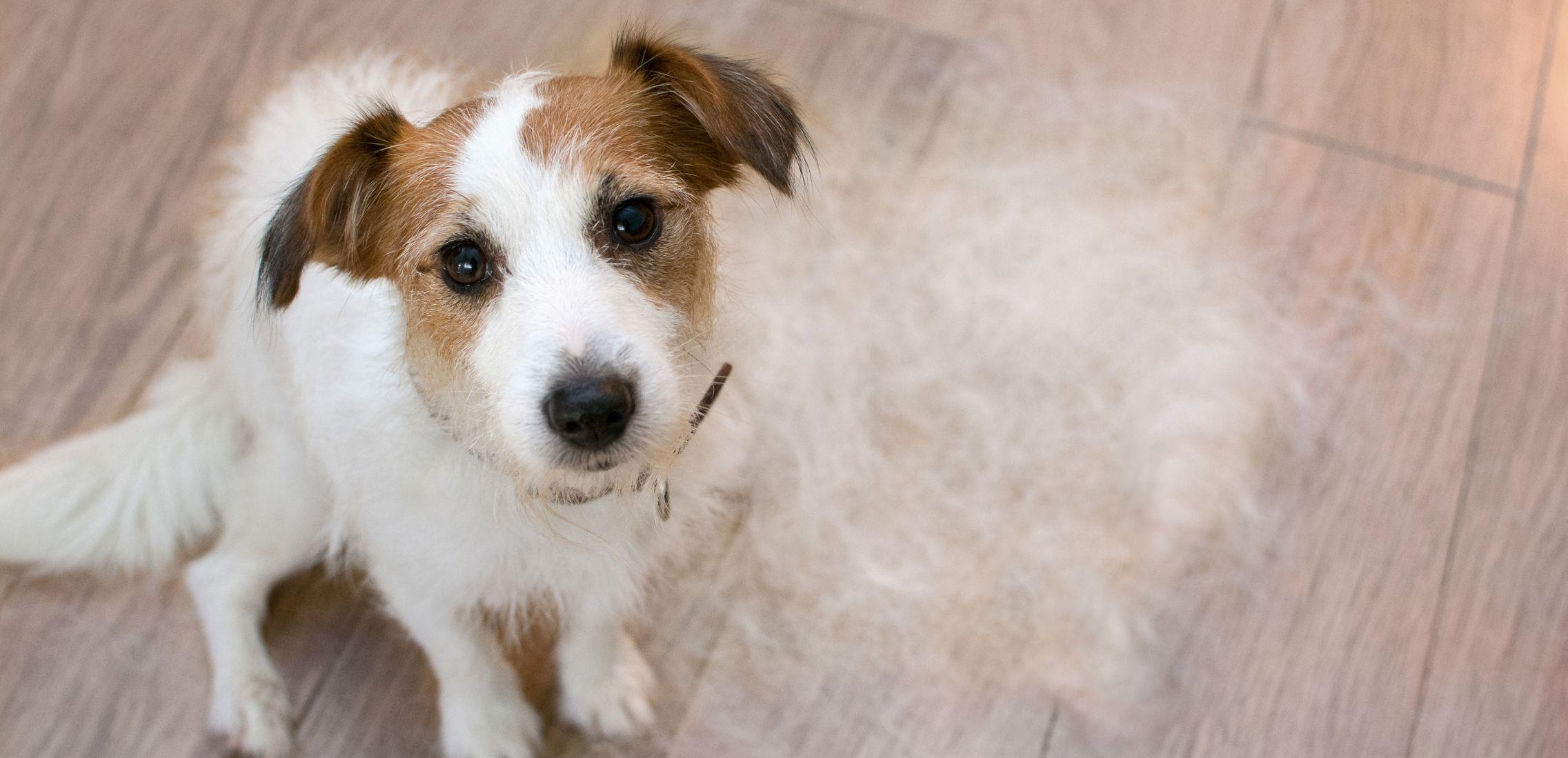Your Cart is Empty
🎉End of Year Sale | Up to 40% OFF
🎉End of Year Sale | Up to 40% OFF
🎉End of Year Sale | Up to 40% OFF

Do you notice an uptick in dog hair around the house as summer rolls in? Find yourself vacuuming much more frequently to get rid of those furry tumbleweeds? You’re not alone! Dog shedding can be a common frustration for pet owners, especially when the amount of fur shed seems to ever-increase during the summer.
But, why do dogs shed more in the summer? And is there anything we can do to help minimize the amount they do shed?
In this article, we’ll answer this question and give you tips on how to manage it. After all, the aim of the game is to help you keep your home clean and your canine companion comfortable.
First, let's start with the basics: Do all dogs shed?
The answer: Yes, all dogs shed to some degree. But the extent and frequency of shedding can vary between breeds.
For instance, single-coated breeds like Poodles shed very little due to their unique coat structure, while double-coated breeds like German Shepherds can shed heavily throughout the year. Think of it as a seasonal wardrobe change—some dogs just have more dramatic reveals!


So now that we know all dogs shed, let's pinpoint why and when this shedding extravaganza begins.
Shedding is a natural process driven by the growth cycle of their hair. Seasonal changes, breed-specific traits, health factors, and stress can influence shedding as well. Nutritional deficiencies, allergies, and hormonal imbalances can likewise increase shedding, while stress from changes in environment or routine can also cause fur to fly.
Dogs typically start shedding around six months old, transitioning from their soft, fluffy puppy coat to their sleek, grown-up fur. As dogs mature, shedding becomes a regular part of life, much like humans shedding hair. It's a continuous cycle of coat renewal, ensuring they always look fabulous. Imagine it as their personal, never-ending spa day!
And there’s more!
As dogs age, their shedding patterns can change due to hormonal shifts or health issues. Older dogs might experience increased shedding or even changes in the texture of their fur. It's like their version of trying out new haircuts or switching up hair care routines.
So, whether your dog sheds enough to knit a sweater or just a few tufts here and there, understanding their shedding cycle helps you manage it better.


Now you have a grasp on when and why dogs shed generally, let’s explore why dog shedding in summer seems to bring out the peak shedding frenzy. Several factors contribute to the increased shedding seen in the summer months:
Temperature Regulation:As temperatures rise, dogs shed their thicker winter coats to improve airflow and cooling. This is especially true for double-coated breeds, which have an insulating undercoat during colder months. The process, often called "blowing coat," helps them stay cool in the heat. It’s their way of saying, “I’m ready for summer!”
Coat Type: The type of coat your dog can significantly impact how much they shed. Dogs with double coats, such as Golden Retrievers and Siberian Huskies, often shed more heavily in the summer as they prepare for warmer weather. Single-coated breeds like Boxers may shed less dramatically but still experience some seasonal shedding.
Health Factors: Allergies, skin irritations, and nutritional deficiencies can also lead to increased shedding. If your dog is shedding excessively beyond the normal seasonal pattern, it might indicate an underlying health issue requiring attention.


Now, you might be wondering when your dog’s fur will be flying most intensely. Here’s a tip: dogs generally shed the most during the spring and fall as they transition between their winter and summer coats.
Summer shedding can be particularly noticeable as dogs prepare for the warmer temperatures. This increased shedding helps them adjust to the heat by removing the heavier winter coat. It's like their personal way of prepping for a summer vacation!
See How Dog Owners Are Using These Leak-Free Potty Pads to Keep Their Homes Clean and Pups Happy
4.7 ⭐⭐⭐⭐⭐
Over 100,000 Dog Owners Saved Money With Potty Buddy™
The washable pee pads that absorb anything your dog throws at them, while keeping your floors and furniture stain-free.
✅ Super Absorbent and Leak-Proof
✅ Great for Potty Training
✅ Ideal for Puppies and Older Dogs
✅ Washable and Reusable For Years
✅ Save over $400/year by not buying disposables
-60 Day Money Back Guarantee-

⭐⭐⭐⭐⭐
-Diana D.
These pads are a life saver for my kitchen floor and bedroom carpet! Just ordered 2 more!




Great! We’ve pinpointed the peak shedding times, but it’s time to address a more serious concern. While shedding is a normal part of a dog's life, excessive shedding can sometimes indicate health issues:
Bald Patches: Bald spots or uneven patches of fur may signal a skin condition or allergy. Take a note when your dog starts to look like it's sporting a new, unintended hairstyle, it could be a red flag for something more serious beneath the surface.


Skin Irritation: Redness, itching, or inflammation can be signs of allergies or parasites like fleas or mites. If your dog is scratching like it’s auditioning for a doggie dance-off, it might be time for a vet visit.
Sudden Increase in Shedding: A sudden change in your dog’s shedding pattern, especially if accompanied by other symptoms like lethargy or changes in appetite, should prompt a visit to the veterinarian.
If you see bald patches, skin irritation, or a sudden increase in shedding, it’s a good idea to consult a veterinarian. Remember: it’s better safe than sorry!
So, how can we tackle the shedding problem head-on? Managing summer shedding involves a mix of grooming, diet, and environmental care:
Regular Grooming:Brush your dog at least once a week, or more frequently during heavy shedding periods. This helps remove loose hair and reduces the amount of fur around your home. For double-coated breeds, an undercoat rake can be particularly effective in managing the increased shedding.
Bathing: Regular baths can help remove loose fur and dirt. Use a gentle, dog-specific shampoo to avoid irritating the skin and to support healthy coat management.


Diet: Ensure your dog’s diet is balanced and includes essential fatty acids, vitamins, and minerals. Foods high in Omega-3 fatty acids, such as fish oil, can improve skin and coat health, potentially reducing shedding. Consulting with a veterinarian about your dog’s dietary needs can be beneficial.
Hydration:Keep your dog well-hydrated, particularly in hot weather. Proper hydration supports healthy skin and can help manage shedding.
Environmental Care: Use pet-friendly vacuums and cleaning products to manage fur around your home. Regularly clean your dog’s bedding and living areas to minimize hair accumulation. It’s all about making your home a fur-free zone!
Consult Your Vet:If your dog’s shedding seems excessive or is accompanied by other symptoms, seek advice from a veterinarian to rule out any health issues. Catching potential problems early can help keep your furry friend happy and healthy.
By understanding the reasons behind your dog’s increased shedding in the summer and using these management strategies, you can help keep your pet comfortable and your home clean throughout the season.
Here’s to a shed-free summer and happy, healthy pups!
Check Out Our Most Popular Content